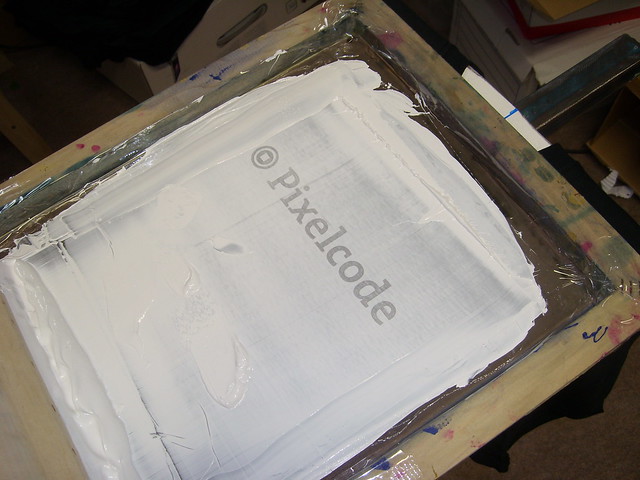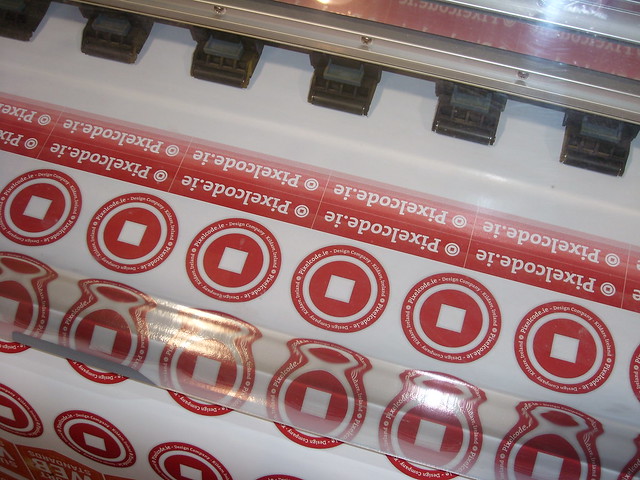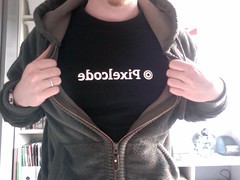As I said in my last post, there is a few loose ends that I want to cover, before I feel that I have completed this topic for good. Creating a new logo is an act in itself, but branding also involves the process of putting your logo on all relevant material and products.
I’m only halfway through branding stuff so far- I’m working on the new Pixelcode website first- I want to work out all design issues on the website before I start branding printed stationery and promotional items. As a web design company, I’d prefer to base all company branding on the company website, rather than design letterheads and business cards and then try to tie the website along with these.
Due to the fact that I don’t have anything to show yet, I thought I’d expand on the list of things I wanted to brand, which I compiled before beginning this project. Hopefully it’ll be of some use to someone about to embark on this tortuous and rewarding exercise.
I have split the items into three lots, the most important and necessary (in my opinion) are first and the level of necessity drops to the ‘great to have but I can run my business without them’ level for the third lot.
Level 1- Stationery or ‘Professional Business Accoutrements'

Letterheads- Gone is the necessity to get a load of letterheads printed- I think most correspondence is done through email nowadays. However, even though I email all my documents as PDFs, I still need a letterhead for invoices, project estimates and cover notes, regardless of the medium.
I may do a tutorial in the future about designing letterheads- there are certain age-old design rules that, when followed, will make your letterheads looks so much better. I will also detail the potential hazards with using your letterhead as a template in your documents. It can be a nightmare job to get your invoicing app to play nice with your letterhead.
Business Cards- If you are out networking with people (always good for business) you will need business cards. In actual fact, if you are in business at all, you should have business cards. Sure your details are online, but a business card is not just an information carrier, it’s a reminder for people to look at your website or to get back in touch.
There are lots of business card design tutorials out there (more so than letterheads) and it’s worth bearing in mind that if you avail of one of those cheap-o business card printing services, that it’ll only reflect poorly on your business. If your card is uninspiring, it is not going to encourage further communication from potential clients.
Compliment Slips- Convenient for including with documents, compliment slips are usually one-third the height of your letterheads and are often simply letterheads with the bottom two-thirds guillotined off. Compliment slips are only of use when printed (you wouldn’t email a compliment slip with personal note written on it, would you?) and with digital printing, you could get a small batch printed. Consider doing an upright slip, for more writing space. Remember, the size of a compliment slip should always be similar to dimensions of a business envelope. If you have to fold it in anyway, it becomes inconvenient.
Envelopes- As with printed letterheads, the days of using enough envelopes to justify a printed run are becoming less and less. Unless you’re doing some sort of mail-shot, forget about printed envelopes, and focus more on stickers for your envelopes. There’s so many ways you could design functional stickers for envelopes, I’ll probably end up doing a separate post on the topic, I love designing stickers.
Level 2- Occasional Promotional items or ‘Additional Accoutrements’

Stickers- One of my favourite promotional items. they’re always a nice item to give away, but also the easiest way to brand everything you send out, especially envelopes (see above). With new digital solvent printing, you can have small amounts of full-colour vinyl stickers with a custom shape at a very economical price. Consider doing stickers that can either double as return address labels or else get two lots done.
Calendars- They walk the fine line between functionality and aesthetics. I like calendars because you have a lot of freedom to produce something visually pleasing, with a functionality that requires the calendar be kept for a year.
You don’t need to produce a 12 page, wire bound publication, a simple single panel with a nice calendar and image can be just as appealing. Look for a good printer who will round-corner it and punch a single hole at the top for hanging and you can have a nice, inexpensive promotional item.
Greeting Cards- Sometimes I think greeting cards can be more of a nuisance than a benefit, but when I don’t have to think about sending out 50 greeting cards at Christmas, I think they’re a nice thought and more personal than a Christmas greeting email.
You could always go the route of a more generic greeting card and use them throughout the year, think ‘Best Wishes’ rather than ‘Merry Christmas’.
Level 3- Fun Promotional items or ‘Silent Marketing Tools’
T-shirts- combining functionality with brand marketing, t-shirts are great to have. There are some decent tutorials out there, some written by dubious sources, but the real considerations you have to bear in mind are cost, storage and getting rid of them.
 If you’re getting t-shirts printed, screen printing is usually only economical on runs of 50+, which means (cost of shirt * 50) + (cost print * 50) + (cost of set-up).
If you’re getting t-shirts printed, screen printing is usually only economical on runs of 50+, which means (cost of shirt * 50) + (cost print * 50) + (cost of set-up).
Then you take delivery of 50 t-shirts that have to be stored in an aired location, away from damaging elements like odours, moisture and possible staining agents.
Then you have to come up with some method of either giving them away or selling them. Sure, everyone has friends that’d love a free t-shirt but if you had t-shirts made to benefit your business, there are only two ways they can do this- impress potential clients/business partners or through selling them.
The first option’s success depends on the person or business you’re trying to impress, but the second option could bring back some cash and profit for your business and possibly open a new line of revenue, if your t-shirts are popular.
Badges- Badges or Buttons as our US cousins call them fall into the same area as stickers, just without the functionality that stickers can have. They’re relatively cheap to get made and can be a cheap, tangible promotional item which you can give to people. I use Modern City in France for badge making, I found their service and prices excellent.
Mugs- These are quite similar in essence to t-shirts. You’ll have to get a large quantity printed, but storage should be easier. If I had the budget for only mugs or t-shirts, I think I’d choose mugs. One size fits all and not only will everyone use them, they’ll probably use them everyday and be constantly looking at your brand and contact details. You can also flog them on your website- who doesn’t love a nice mug?
You can go your own way
The above are just some suggestions, I’m not sure if I’ll get around to doing every item in the three lists but I’ll make a good stab at them over the next year or so.
What you should always consider, when deciding on getting custom branded promotional stuff, is the cost involved in producing the item and what you will get back from it. Of course tangible return is always the best but sometimes the intangible promotion, marketing and good vibes you get from a nice promotional piece is worth it on it’s own.
I hope I have provided some food for thought, this is the final piece in the ‘Rebranding Pixelcode’ exercise. In the process of branding some of the above, I hope to produce a couple of tutorials, to provide help and ideas for your own business stationery and promotional items.
If I’ve missed anything or if you have any queries, please contact me and I’ll do my best to help.